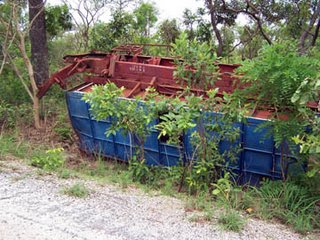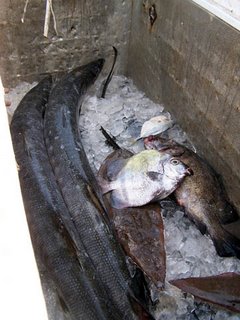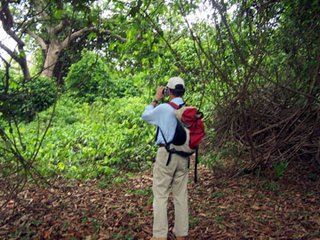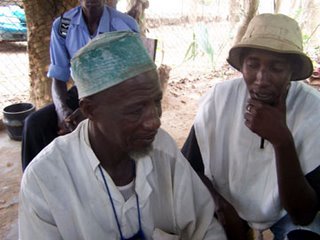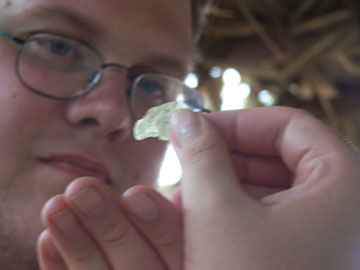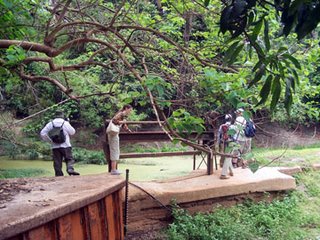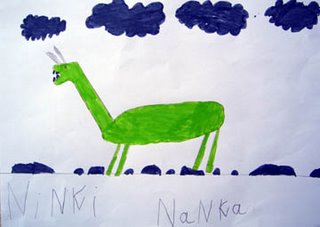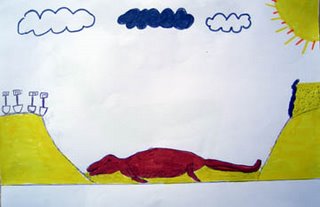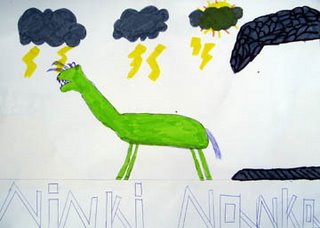For immediate release:
21 July 2006
Six explorers from the Centre for Fortean Zoology [CFZ] - the world’s largest organization studying mystery animals - have returned from a two-week expedition to the West African country of The Gambia. The CFZ are happy to announce that the expedition was a resounding success.
One of the most interesting findings was that not only is there still – at the beginning of the 21st Century – a firm belief in, and fear of, a monster called the Ninki Nanka in The Gambia, but that practically everything that has been written about the animal in the west has been wrong. The hunt for Ninki Nanka started decades ago, after Dr. Thomas Dalrymple, a retired Medical Officer from H.M Colonial Civil Service, reported having heard of a dragon-like creature in the Gambia River in 1935. Since then, the creature has appeared in dozens of books on mystery animals – always portrayed as a giant lizard or dinosaur-like creature!
The `J.T.Downes memorial expedition`, which returned to the UK a few days ago, can conclusively report that all the evidence actually points to an unknown species of giant snake, possibly with horn-like growths on its head.
“The sense of terror that this creature engenders is palpable”, says Richard Freeman (36), the Zoological Director of the CFZ. “Even Park Rangers refused to take us into areas where they believed this creature to live. Everyone reported it as being a huge snake with reflective scales and a crest. Most people fear it so much that they believe that to see it is death”.
The expedition garnered more information than ever before on the animal including:
An eye-witness who claims to have seen Ninki Nanka within the past few years
Information on three possible western eyewitnesses of Ninki Nanka
Links between the Ninki Nanka and pre-Muslim animist religions of The Gambia
New data on sightings at Abuko national park in 1943 and 1947.
However, it appears that the animal is now extinct in the lower reaches of The Gambia at least, and plans are now afoot to launch another expedition to investigate recent reports, further inland, in Guinea.
But the expedition also went to solve another mystery – that of a mysterious carcass buried on Bungalow Beach in 1983. “Amateur naturalist Owen Burnham tells a story about how, as a teenager, he witnessed the carcass of a massive sea creature that resembled a pliosaur being buried on the beach. Pliosaurs became extinct about 65 million years ago, and so if we had managed to dig up bones of a contemporaneous specimen, it would be a big deal indeed” said Oll Lewis (26), the expedition’s ecologist.
Sadly, although the expedition excavated the beach, they found no bones, and discovered that the carcass would have rotted away years ago, because despite Burnham’s hope that it had been buried above the tide line, as soon as the hole was under a foot deep it began to fill with seawater.
However, the team did interview a witness to the original incident, who described it as a huge “dolphin”, but without a dorsal fin. Whether the fin had been removed by trauma, or it is a rare species without one is unknown, but expedition leader Chris Moiser (51), a Plymouth based zoologist, and long-term member of the Permanent Directorate of the CFZ believes that it may be one of the beaked whales; obscure and little known species which are found in most of the world’s oceans. “Some are only known from bones, and we have no idea what they look like alive” he said.
The final objective of the expedition was also a success. Armitage’s skink (Chalcides armitagei) is a small lizard known only from three specimens found in 1922, and a handful of others about fifteen years ago. The only area where the animal was known to live was cleared for development some years ago, and it was feared that the species was either on the edge of extinction or had gone forever.
The expedition failed in its hope of producing the first film of the living animals, but did manage to locate people who have seen it recently, and can announce that the known habitat for the creature has now been extended by 20-30 miles from the original place where it was found. “This is excellent news” said CFZ Director Jon Downes (46) who co-ordinated Mission Control at the CFZ headquarters in rural North Devon. “That means that the species may be viable after all, and would seem to be an excellent candidate for a captive breeding and reintroduction programme”.
The expedition will present their findings at the annual CFZ Conference in August, when a book of the expedition will be published.
ENDS
NOTES FOR EDITORS:+ The Centre for Fortean Zoology is a non profit-making organisation, which was founded in 1992. Over the last 14 years we have mounted expeditions to Central America, Puerto Rico, Thailand, Mexico, Mongolia, Sumatra, and various parts of the United States, as well as numerous investigations in the UK. Further information on the CFZ can be found on the website, www.cfz.org.uk.
+ Team members were· Chris Moiser: Zoologist and team leader· Dr Chris Clark: Engineer· Lisa Dowley: First aid and security expert· Richard Freeman: cryptozoologist· Oll Lewis: Ecologist· Suzi Marsh: computer expert
+ Future CFZ projects include an online TV Station (
www.cfztv.com), and the first museum of cryptozoology in Europe, on which building work will begin this autumn.+ C F Z director Jonathan Downes has written numerous books on the subject of mystery animals. The latest, entitled `Monster Hunter` is his long awaited autobiography. Zoological Director Richard Freeman is the author of `Dragons: More than a myth?`, the first scientific look at the subject since the late 19th century, and expedition leader Chris Moiser is the author of several books including `Mystery Sea-serpents of the south-west` (Bossiney books).+ The honorary life President of the Centre for Fortean Zoology is renowned explorer, author and soldier Colonel John Blashford-Snell OBE, best known for his pioneering Operation Drake and Operation Raleigh expeditions during the 1970s.
+ The expedition was dedicated to the memory of the late J.T.Downes I.S.O, a West African explorer and colonial service officer, and father of the director of the CFZ. He died in February and donations to the expedition fund were made in his name.+ The CFZ is looking for corporate and private sponsors
+ Pictures from the expedition are available, and Richard Freeman is available for interview. Please telephone Jon or Oll on +44 (0)1237 431413


























